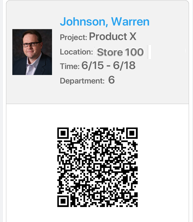"Badges? We ain't got no badges. We don't need no badges. I don't have to show you any stinkin' badges!"
Many people have quoted the 1948 Humphrey Bogart film, The Treasure of the Sierra Madre, without realizing it. In the film Bogart, pinned down by Mexican bandits, asks to see some form of proof that they are the Federales they claim to be. Their response has been quoted and imitated in dozens of movise, TV shows and books ever since.
While a lack of badges proved no problem for outlaws in the Sierra Madre, today's retail environment requires more identification for store associates and 3rd-party vendors alike. In today's world of increased security concerns and mounting pressures to do more with fewer resources, store managers need to know "who's in my store" (WIMS) and what those people are doing.
Retailers have used plastic badges pinned to employee uniforms to identify store associates and other workers coming into a store for years. Unfortunately, these types of badges don't adequately identify other workers (setting up displays for brands or conducting product demonstrations) who come into a store. These static, physical badges don't tell us anything about why someone is in a store or what they should be doing that day. And honestly, anyone can go down to their local office supply store and have a badge made for $10.
 Digital badges solve each of those problems handily. A digital badge dynamically identifies both the worker in-store and the task they are authorized to perform at a specific time.
Digital badges solve each of those problems handily. A digital badge dynamically identifies both the worker in-store and the task they are authorized to perform at a specific time.
Displayed on a mobile device, these badges can also give store managers the ability to contact the worker's manager with questions or even rate the quality of the work performed. With the integration of something like a QR code, there's no limit to what information a badge could display or allow a store manager to access.
In a typical use case, a third-party worker would check into a store using their digital badge. This badge would identify them and the company for which they work. It would also spell out what time they are assigned to work in the store and the project on which they are working. They might scan in to the store, if the retailer supports that functionality, or merely show the badge to a store manager. As mentioned above, the manager might scan the badge with an app on their own mobile device.
This kind of badging will also give usable statistics and data to retailers and the managers of these workers in-store. Historical data on store visits by suppliers and third-party labor providers as well as work done in-store can help inform work planning and merchandising activities in the future.
We may not have the flying cars and jetpacks promised us by many popular visions of futuristic technology, but digital badging is one bit of futuristic tech that exists today and can immediately impact store operations, and ultimately the overall retail experience for customers.
Want to start at the beginning? Learn what's at the heart of retail execution.



